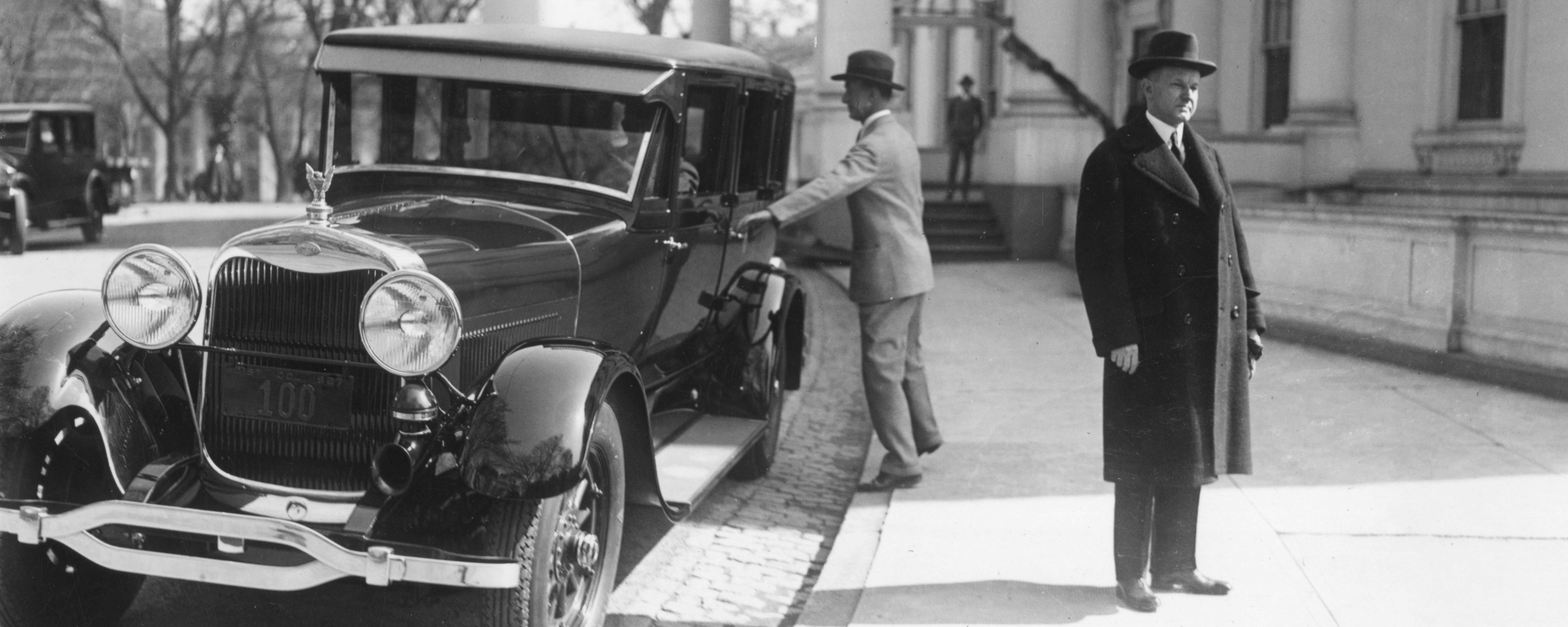Memories of Silent Cal

Oral history transcriptions
Click a name below for more information. All transcripts are in PDF format.
Background information
Calvin Coolidge became president of the United States as a consequence of Warren Harding’s death from a cerebral embolism on August 2, 1923. Coolidge completed Harding’s term and was elected to a term of his own in 1924, finally leaving office in March 1929. He was fortunate to have been president during a period of relative peach and expanding apparent prosperity. His conservative Republican policies of inaction toward domestic and international problems came to symbolize the era between World War I and the Great Depression. He skillfully restored integrity to government following the Harding scandals, and his plain-and-simple style was an appealing sign of calm and stability during the Roaring Twenties.
Coolidge was born on July 4, 1872, in tiny Plymouth Notch, Vermont. He represented the fifth generation of a family that had cleared land around Plymouth during the American Revolution. His grandfather owned the country store; and his father farmed, ran the annual town meeting, and served terms in the Vermont House and Senate. As a boy, Calvin worked hard at farm chores, attended a one-room school house, and led a simple life, seldom venturing beyond the Notch. His father said the he “never made any rules for Calvin to follow. If there are rules, it gives a boy a chance to break them. I told him to do his work well, and he always did. That was what my father taught me, and that was what his father taught him.”
After finishing public school, Calvin spent four years at Black River Academy in Ludlow and one semester at St. Johnsbury Academy, and then entered Amherst College in Massachusetts. He practiced law in Northampton after graduation, met and married Grace Goodhue, from Burlington, Vermont, and gradually made his way up the political ladder in Massachusetts to become governor in 1918. He gained national fame through his handling of the Boston Police Strike of 1919, earning himself a place on the national Republican ticket with Warren Harding in 1920. Harding’s death three years later put Coolidge in the White House.
At the time Coolidge became president he had never been outside the United States and seldom outside New England. Nevertheless, he had traveled a considerable distance from his rural Vermont childhood. In fact, the British ambassador commented, “I never saw a man who looked less like the son of a farmer” (Arthur Schlesinger, Jr., Crisis of the Old Order, p. 56). Coolidge, however, returned often to Vermont, to visit his father at Plymouth Notch. He was there when he learned of Harding’s death; and it was in the living room of the family farmhouse by the light of an oil lamp that his justice-of-the-peace father administered the oath of office as president. Because his father had refused to have a telephone, the nearest one was in the store across the road, and it was from that phone that he received the advice from Secretary of State Charles Evans Hughes to take the oath of office immediately. The next day, telephone linemen strung a wire into his father’s house.
Although Coolidge left the Green Mountain State at age 19, his rural Vermont background stamped his personality, philosophy, and leadership. By most measures he was an unspectacular man. Small of build, with sandy hair, a high forehead and prominent nose, he was not impressive physically. Nor was he a gifted speaker; his voice had a nasal twang, and his habit of speech was brief, direct, and prone to silvery platitudes. In personal relations he was “silent Cal,” serious and aloof. One story suffices to illustrate his well-know “closedmouthedness.” During the 1924 presidential campaign a newsman sought Coolidge out. “Mr. President,” he asked, “what do you think of Prohibition?” “No comment,” replied Coolidge. “Will you say something about unemployment?” “No,” said Coolidge. “Will you tell us your views about the world situation?” persisted the reporter. “No.” “About your message to Congress?” “No.” The disappointed reporter started to leave, but as he reached the door Coolidge said, “Wait.” Hopefully, the man turned around and Coolidge cautioned: “Now remember—don’t quote me.”
These characteristics, along with his severe public dignity, diffidence, shrewd political common sense, and numerous eccentricities (preserved in widely circulated anecdotes, may of which were authentic) are generally attributed by his biographer to the narrow austerity and rural isolation of his Vermont youth. They were, as well, apparently, the key to his enormous political popularity: He epitomized cherished virtues that seemed to be rapidly vanishing during the Jazz Age decade.
From history’ perspective, Calvin Coolidge is the most obscure of twentieth-century U.S. presidents. Yet, public attention turned to him again, briefly, with the election of Ronald Reagan to the presidency. Reagan chose to hand a portrait of Coolidge in the cabinet room of the White House. He admired Coolidge for his success in reducing taxes and government expenditures, but also for his vision of American, which, like Reagan’s own, was nostalgically rooted in small town and rural values of a time gone by.
—Gene Sessions
For further reading:
Donald R. McCoy, Calvin Coolidge, the Quiet President (1967).
William Allen White, A Puritan in Babylon: The Story of Calvin Coolidge (1938)
Paul Boller, Presidential Campaigns (1984): 218-222.
Howard F. McMains, ed. “Retort and Ripostes: President Coolidge’s Cabinet Room Humor,” Vermont History 54 (1986): 229-232.
James Morgan, Our Presidents (1935): 299-317.
Calvin Coolidge Memorial Foundation, http://www.calvin-coolidge.org/
Citation for this page
Woodsmoke Productions and Vermont Historical Society, “Memories of Silent Cal,” The Green Mountain Chronicles radio broadcast and background information, original broadcast 1988-89. https://vermonthistory.org/memories-of-silent-cal